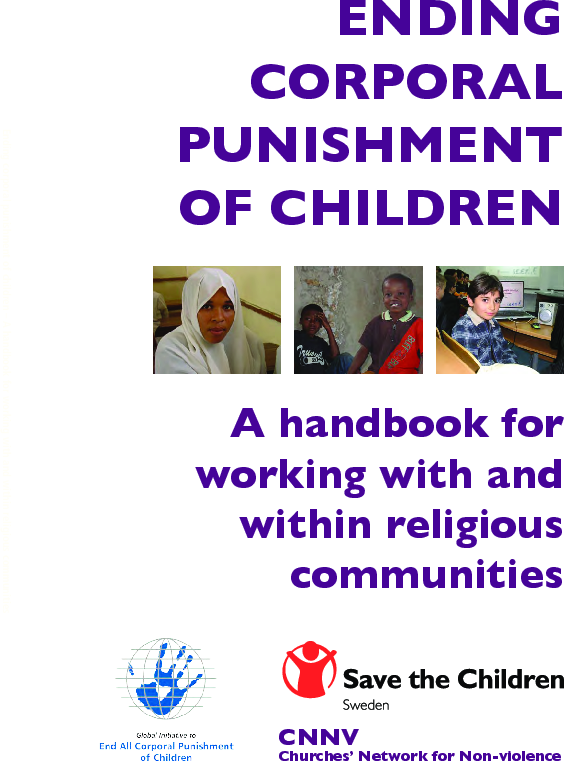
Manuals, Toolkits and Guidance
Ending corporal punishment of children. A handbook for working with and within religious communities
Publication year:
2011
English
Format:
pdf (1.3 MiB)
Publisher:
Churches' Network for Non-violence,Global Initiative to End All Corporal Punishment of Children,Save the Children Sweden
A handbook for working with and within religious communities on how to end corporal punishment of children, developed jointly by Global Initiative to End all Corporal Punishment of Children, Churches’ Network for Non Violence and Save the Children Sweden. It aims to help those working with and within religious communities to summon up faith-based support for full legal reform to end all corporal punishment of children.The handbook includes the following sections: Section 2, Corporal punishment of children – a global problem, discusses the prevalence of corporal punishment and its impact on children’s lives, children’s perspectives, the importance of legal reform and progress towards reform worldwide. It also includes examples of the involvement of religious leaders. Section 3, Children’s right to protection from corporal punishment, looks at the United Nations Convention on the Rights of the Child and how the guiding principles of the Convention are relevant to religious practice. A brief overview of the UN Secretary-General’s Study on Violence against Children is given. Section 4, Religious perspectives, discusses the challenges posed by faith-based opposition to corporal punishment and ways of responding to them. It looks at faith-based support for prohibiting corporal punishment and gives a brief account of some of the teachings about children and non-violence from the major world religions, including the Golden Rule. Section 5, Working with faith groups to achieve reform, and Section 6, Taking action through religious leaders’ existing roles and functions, address ways of engaging with religious leaders and organisations and developing multi-religious support and partnership at every level. They discuss ways in which the diverse roles and functions of religious leaders provide unique opportunities for action towards prohibiting and eliminating corporal punishment. Examples of faith-based initiatives are included, together with further suggestions for taking action. Section 7, Resources, provides information on further resources relevant to each main section in the handbook, including links to downloadable resources and useful websites.
Read full abstract
Authors
View & Download
Document information
Publisher
Authors
Format
Content type
Topics
Rights
© Author/Publisher
Found a mistake? Help us improve!
If you have noticed a document assigned to the wrong author or any other inaccuracies, let us know! Your feedback helps us keep our data accurate and useful for everyone.
Share
Link
